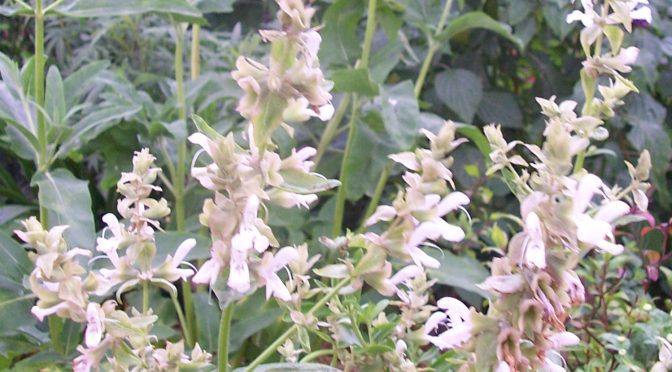Salvia canariensis ‘Alba’: is an open bushy shrub, 1.2-1.5mH for a sunny position with large slender hastate leaves, pure white flowers and green calyces.

Salvia canariensis ‘Alba’ is similar to the parent plant but with white flowers.
Flowers: are large white falcate shaped flowers. The hood is very long with the stigma being exerted. The lower lobes are long , slender and slightly cupped to act as a landing place for bees and other insects. The throat is open wide to help attract the insect to go into the flower.
Flowers appear in Spring, through summer as whorls of 4-6 flowers in clusters of loose panicles at the top of a long green flower stem, well above the foliage to catch passing insects.
Calyces: are green, large and papery , ribbed with slightly pointed lobes. The green bracts remain for some time after the flowers emerge. After the flowers have fallen, the calyces remain, drying and becoming papery, so it seems as if the plant is still flowering through autumn.
Leaves: are a grey green colour and hastate shaped. These begin as slender leaves and gradually widen to approx 6-8cm wide.
As the stems become woody, leaf stems appear in pairs at either side of the main stem.
Salvia canariensis ‘Alba’ is a architectural feature plant for any garden.
This is a perfect plant for a white or silver garden with it’s grey leaves and pure white flowers. Plant with other pastel coloured shrubs and perennials, with shades of mauve, purple, bright yellow and cerise or pale pink.
As the stems become woody, the area beneath the plant is ideal for other small perennials to protect the base in a windy situation.
S. canariensis is a tough, hardy plant for full sun, tolerating hot dry summers, cold winters and light frosts.
When the main flowering period is over, cut off all the papery calyces, trim and cut all stems back to a good green set of buds. Feed and mulch well to keep the root area cool over the summer months.
Propagation: usually by tip cuttings from new growth only in spring and summer. Cuttings from old growth has a low strike rate.
Occasionally available
Back to Varieties



